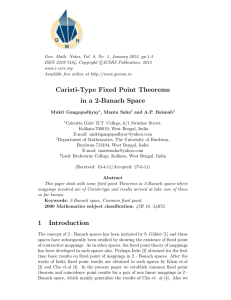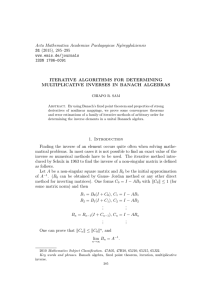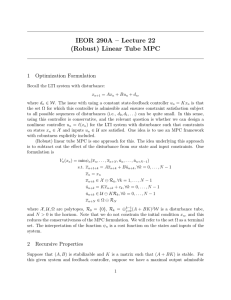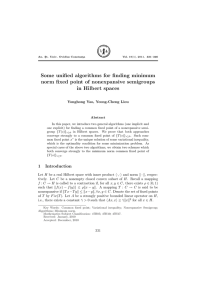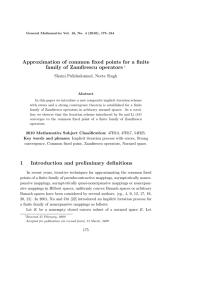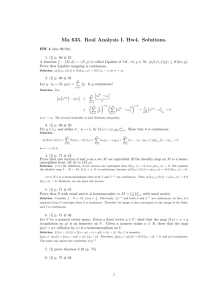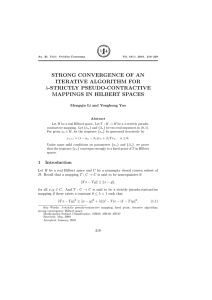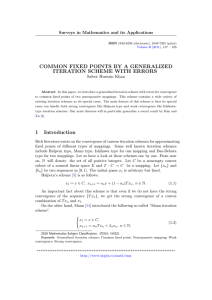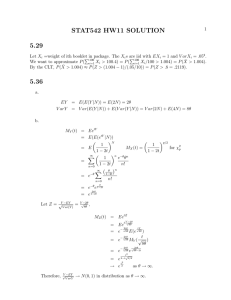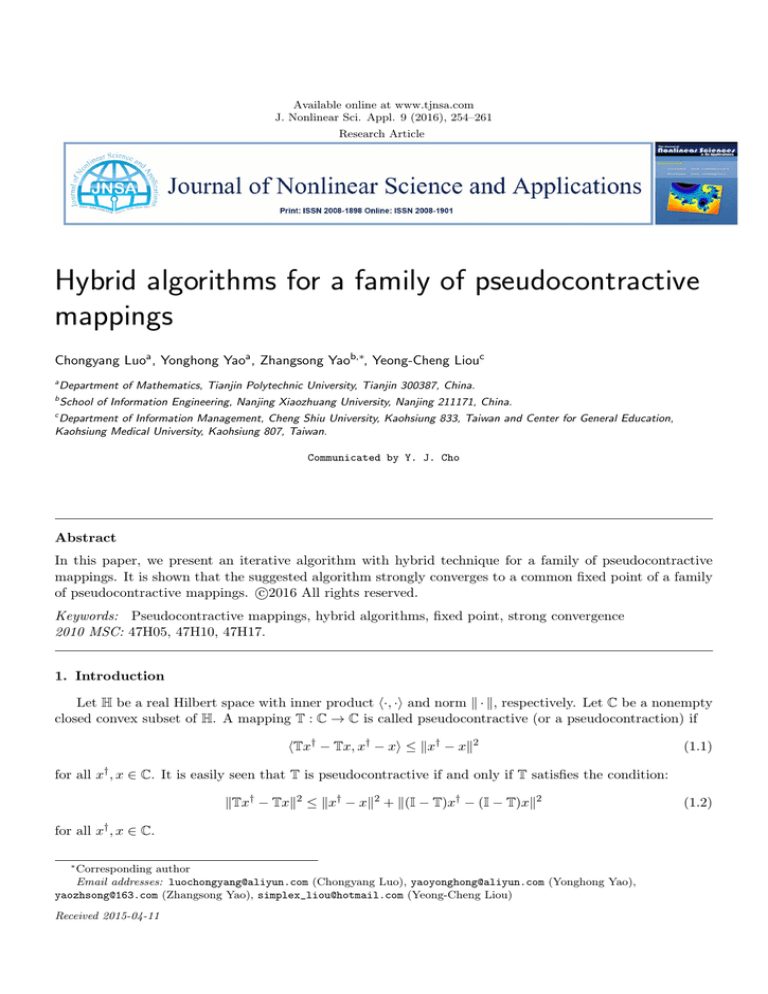
Available online at www.tjnsa.com
J. Nonlinear Sci. Appl. 9 (2016), 254–261
Research Article
Hybrid algorithms for a family of pseudocontractive
mappings
Chongyang Luoa , Yonghong Yaoa , Zhangsong Yaob,∗, Yeong-Cheng Liouc
a
Department of Mathematics, Tianjin Polytechnic University, Tianjin 300387, China.
b
School of Information Engineering, Nanjing Xiaozhuang University, Nanjing 211171, China.
c
Department of Information Management, Cheng Shiu University, Kaohsiung 833, Taiwan and Center for General Education,
Kaohsiung Medical University, Kaohsiung 807, Taiwan.
Communicated by Y. J. Cho
Abstract
In this paper, we present an iterative algorithm with hybrid technique for a family of pseudocontractive
mappings. It is shown that the suggested algorithm strongly converges to a common fixed point of a family
c
of pseudocontractive mappings. 2016
All rights reserved.
Keywords: Pseudocontractive mappings, hybrid algorithms, fixed point, strong convergence
2010 MSC: 47H05, 47H10, 47H17.
1. Introduction
Let H be a real Hilbert space with inner product h·, ·i and norm k · k, respectively. Let C be a nonempty
closed convex subset of H. A mapping T : C → C is called pseudocontractive (or a pseudocontraction) if
hTx† − Tx, x† − xi ≤ kx† − xk2
(1.1)
for all x† , x ∈ C. It is easily seen that T is pseudocontractive if and only if T satisfies the condition:
kTx† − Txk2 ≤ kx† − xk2 + k(I − T)x† − (I − T)xk2
for all x† , x ∈ C.
∗
Corresponding author
Email addresses: luochongyang@aliyun.com (Chongyang Luo), yaoyonghong@aliyun.com (Yonghong Yao),
yaozhsong@163.com (Zhangsong Yao), simplex_liou@hotmail.com (Yeong-Cheng Liou)
Received 2015-04-11
(1.2)
C. Luo, Y. Yao, Z. Yao, Y. C. Liou, J. Nonlinear Sci. Appl. 9 (2016), 254–261
255
Interest in pseudocontractive mappings stems mainly from their firm connection with the class of nonlinear monotone or accretive operators. It is a classical result, see Deimling [9], that if T is an accretive
operator, then the solutions of the equations Tx = 0 correspond to the equilibrium points of some evolution
systems. It is now well-known that Mann’s algorithm [11] fails to converge for Lipschitzian pseudocontractions. This explains the importance, from this point of view, of the improvement brought by the Ishikawa
iteration which was introduced by Ishikawa [10] in 1974. The original result of Ishikawa is stated in the
following.
Theorem 1.1. Let C be a convex compact subset of a Hilbert space H and let T : C → C be a Lipschitzian
pseudocontractive mapping and x1 ∈ C. Then the Ishikawa iteration {un } defined by
(
vn = (1 − ηn )un + ηn Tun ,
(1.3)
un+1 = (1 − ξn )un + ξn Tvn
for all n ∈ N, where {ξn }, {ηn } are sequences of positive numbers satisfying
(i) 0 ≤ ξn ≤ ηn ≤ 1;
(ii) limn→∞ ηn = 0;
P∞
(iii)
n=1 ξn ηn = ∞,
converges strongly to a fixed point of T.
However, strong convergence of (1.3) has not been achieved without compactness assumption on T or
C. Consequently, considerable research efforts, especially within the past 40 years or so, have been devoted
to iterative methods for approximating fixed points of T when T is pseudocontractive (see for example [2],
[5]-[7], [13], [15], [16], [18]-[24] and the references therein). On the other hand, some convergence results are
obtained by using the hybrid method in mathematical programming, see, for example, [1], [3], [4], [12] ,[14],
[17] and [20]. Especially, Cho, Qin and Kang [8] presented a hybrid projection algorithm and proved the
following strong convergence theorem.
Theorem 1.2. Let C be a nonempty closed and convex subset of a real Hilbert space H. Let
T ∆ be an index set
and T(t) : C → C, where t ∈ ∆, a demicontinuous pseudocontraction. Assume that F := t≥0 F ix(T(t)) 6= ∅.
Let {xn } be a sequence generated in the following iterative process:
x0 ∈ H, chosen arbitrarily,
T
C1 (t) = C, C1 = t∈∆ C1 (t), x1 = projC1 (x0 ),
y (t) = α (t)x + (1 − α (t))T(t)y (t),
n
n
n
n
n
(1.4)
2
Cn+1 (t) = {z ∈ Cn (t) : kyn (t) − zk ≤ kxn − zk2 − (1 − αn (t))2 kxn − T(t)yn (t)k2 },
T
Cn+1 = t∈∆ Cn+1 (t),
x
∀n ≥ 1.
n+1 = projCn+1 (x0 ),
Assume that the sequence {αn (t)} ⊂ (0, 1) satisfies the condition limsupn→∞ αn (t) < 1 for every t ∈ ∆.
Then the sequence {xn } generated by (1.4) converges strongly to projF (x0 ).
Inspired by the above results, the purpose of this article is to construct a new algorithm which couples
Ishikawa algorithms with hybrid techniques for finding the fixed points of a family of Lipschitzian pseudocontractive mappings. Strong convergence of the presented algorithm is given without any compactness
assumption imposed on the operators.
2. Preliminaries
Recall that a mapping T : C → C is called ζ−Lipschitzian if there exists ζ > 0 such that
kTx† − Txk ≤ ζkx† − xk
C. Luo, Y. Yao, Z. Yao, Y. C. Liou, J. Nonlinear Sci. Appl. 9 (2016), 254–261
256
for all x† , x ∈ C.
We will use F ix(T) to denote the set of fixed points of T, that is, F ix(T) = {v ∈ C : v = Tv}. Recall
that the (nearest point or metric) projection from H onto C, denoted projC , assigns, to each u ∈ H, the
unique point projC (u) ∈ C with the property
ku − projC (u)k = inf{ku − xk : x ∈ C}.
It is well known that the metric projection projC of H onto C is characterized by
hu − projC (u), v − projC (u)i ≤ 0
(2.1)
for all u ∈ H, v ∈ C. It is well-known that in a real Hilbert space H, the following equality holds:
kαu + (1 − α)vk2 = αkuk2 + (1 − α)kvk2 − α(1 − α)ku − vk2
(2.2)
for all u, v ∈ H and α ∈ [0, 1].
Lemma 2.1. ([24]) Let H be a real Hilbert space, C a closed convex subset of H. Let T : C → C be a
continuous pseudocontractive mapping. Then
(i) F ix(T) is a closed convex subset of C.
(ii) (I − T) is demiclosed at zero.
In the sequel we shall use the following notations:
• ωw (un ) = {u : ∃unj → u weakly} denote the weak ω-limit set of {un };
• un * u stands for the weak convergence of {un } to u;
• un → u stands for the strong convergence of {un } to u.
Lemma 2.2. ([12]) Let C be a closed convex subset of H. Let {un } be a sequence in H and u ∈ H. Let
q = projC u. If {un } is such that ωw (un ) ⊂ C and satisfies the condition
kun − uk ≤ ku − qk
for all n ∈ N.
Then un → q.
3. Main results
In this section, we state our main results. Let C be a nonempty closed convex subset of a real Hilbert
space H. Let ∆ beTan index set and T(t)t∈∆ : C → C be an η-Lipschitzian pseudocontractive mapping.
Assume that z = t∈∆ F ix(T(t)) 6= ∅. Firstly, we present our new algorithm which couples Ishikawa’a
algorithm (1.3) with the hybrid projection algorithm.
T
Algorithm 3.1. Let x0 ∈ H. For C1 (t) = C, C1 = t∈∆ C1 (t) and x1 = projC1 (x0 ), define a sequence
{xn } of C as follows:
yn (t) = (1 − ςn (t))xn + ςn (t)T(t)xn ,
zn (t) = %n (t)xn + (1 − %n (t))T(t)yn (t),
(3.1)
Cn+1 (t) = {x∗ ∈ Cn (t), kzn (t) − x∗ k ≤ kxn − x∗ k},
T
Cn+1 = t∈∆ Cn+1 (t),
xn+1 = projCn+1 (x0 ),
for all n ≥ 1, where {ςn (t)} and {%n (t)} are two sequences in [0, 1].
C. Luo, Y. Yao, Z. Yao, Y. C. Liou, J. Nonlinear Sci. Appl. 9 (2016), 254–261
257
In the sequel, we assume the sequences {ςn (t)} and {%n (t)} satisfy the following conditions
1
0 < k ≤ 1 − %n (t) ≤ ςn (t) < p
1 + η2 + 1
for all n ∈ N.
Remark 3.2. Without loss of generality, we can assume that the Lipschitz constant η > 1. If not, then T(t)
is nonexpansive for all t ∈ ∆. In this case, Algorithm 3.1 is trivial. So, in this article, we assume η > 1. It
is obvious that √ 1
< η1 for all n ≥ 1.
1+η 2 +1
We prove the following several lemmas which will support our main theorem below.
T
⊂ Cn for n ≥ 1 and {xn } is well defined.
T
Proof. We
use
mathematical
induction
to
prove
t∈∆ F ix(T(t)) ⊂ Cn (t) for all n ∈ N.
T
(i) t∈∆ F ix(T(t))
⊂
C
(t)
=
C
is
obvious.
1
T
T
(ii) Suppose that t∈∆ F ix(T(t)) ⊂ Ck (t) for some k ∈ N. Take u ∈ t∈∆ F ix(T(t)) ⊂ Ck (t).
From (3.1), we have by using (2.2) that,
Lemma 3.3.
t∈∆ F ix(T(t))
kzn (t) − uk2 = k%n (t)(xn − u) + (1 − %n (t))(T(t)((1 − ςn (t))xn + ςn (t)T(t)xn ) − u)k2
= %n (t)kxn − uk2 + (1 − %n (t))kT(t)((1 − ςn (t))xn + ςn (t)T(t)xn ) − uk2
(3.2)
2
− %n (t)(1 − %n (t))kxn − T(t)((1 − ςn (t))xn + ςn (t)T(t)xn )k .
Since u ∈
T
t∈∆ F ix(T(t)),
we have from (1.2) that
kT(t)x − uk2 ≤ kx − uk2 + kx − T(t)xk2
for all x ∈ Ck (t).
From (2.2) and (3.3), we obtain
kT(t)((1 − ςn (t))xn + ςn (t)T(t)xn ) − uk2
≤ k(1 − ςn (t))xn + ςn (t)T(t)xn − T(t)((1 − ςn (t))xn + ςn (t)T(t)xn )k2
+ k(1 − ςn (t))xn + ςn (t)T(t)xn − uk2
= k(1 − ςn (t))(xn − T(t)((1 − ςn (t))xn + ςn (t)T(t)xn ))
+ ςn (t)(T(t)xn − T(t)((1 − ςn (t))xn + ςn (t)T(t)xn ))k2
+ k(1 − ςn (t))(xn − u) + ςn (t)(T(t)xn − u)k2
= (1 − ςn (t))kxn − T(t)((1 − ςn (t))xn + ςn (t)T(t)xn )k2
+ ςn (t)kT(t)xn − T(t)((1 − ςn (t))xn + ςn (t)T(t)xn )k2
− ςn (t)(1 − ςn (t))kxn − T(t)xn k2 + (1 − ςn (t))kxn − uk2 + ςn (t)kT(t)xn − uk2
− ςn (t)(1 − ςn (t))kxn − T(t)xn k2
≤ (1 − ςn (t))kxn − uk2 + ςn (t)(kxn − uk2 + kxn − T(t)xn k2 )
− ςn (t)(1 − ςn (t))kxn − T(t)xn k2
+ (1 − ςn (t))kxn − T(t)((1 − ςn (t))xn + ςn (t)T(t)xn )k2
+ ςn (t)kT(t)xn − T(t)((1 − ςn (t))xn + ςn (t)T(t)xn )k2
− ςn (t)(1 − ςn (t))kxn − T(t)xn k2 .
(3.3)
C. Luo, Y. Yao, Z. Yao, Y. C. Liou, J. Nonlinear Sci. Appl. 9 (2016), 254–261
258
Note that T(t) is η-Lipschitzian for all t ∈ ∆. It follows that
kT(t)((1 − ςn (t))xn + ςn (t)T(t)xn ) − uk2
≤ (1 − ςn (t))kxn − uk2 + ςn (t)(kxn − uk2 + kxn − T(t)xn k2 )
− ςn (t)(1 − ςn (t))kxn − T(t)xn k2
+ (1 − ςn (t))kxn − T(t)((1 − ςn (t))xn + ςn (t)T(t)xn )k2
+ ςn3 (t)η 2 kxn − T(t)xn k2
(3.4)
− ςn (t)(1 − ςn (t))kxn − T(t)xn k2
= kxn − uk2 + (1 − ςn (t))kxn − T(t)((1 − ςn (t))xn + ςn (t)T(t)xn )k2
− ςn (t)(1 − 2ςn (t) − ςn2 (t)η 2 )kxn − T(t)xn k2 .
By condition ςn (t) < √
1
,
1+η 2 +1
we have 1 − 2ςn (t) − ςn2 (t)η 2 > 0. Substituting (3.4) to (3.2), we have
kzn (t) − uk2 = %n (t)kxn − uk2 + (1 − %n (t))kT(t)((1 − ςn (t))xn + ςn (t)T(t)xn ) − uk2
− %n (t)(1 − %n (t))kxn − T(t)((1 − ςn (t))xn + ςn (t)T(t)xn )k2
≤ %n (t)kxn − uk2 + (1 − %n (t))[kxn − uk2
+ (1 − ςn (t))kxn − T(t)((1 − ςn (t))xn + ςn (t)T(t)xn )k2 ]
− %n (t)(1 − %n (t))kxn − T(t)((1 − ςn (t))xn + ςn (t)T(t)xn )k2
= kxn − uk2 + (1 − %n (t))(1 − ςn (t) − %n (t))kxn − T(t)((1 − ςn (t))xn
+ ςn (t)T(t)xn )k2 .
Since ςn (t) + %n (t) ≥ 1, we deduce
kzn (t) − uk ≤ kxn − uk.
(3.5)
Hence u ∈ Ck+1 (t). This implies that
\
F ix(T(t)) ⊂ Cn (t)
t∈∆
for all n ∈ N. Therefore,
\
F ix(T(t)) ⊂
t∈∆
\
Cn (t) = Cn .
t∈∆
Next, we show that Cn is closed and convex for all n ∈ N. It suffices to show that, for each fixed
but arbitrary t ∈ ∆, Cn (t) is closed and convex for each n ≥ 1. It is obvious that C1 (t) = C is closed
and convex. Suppose that Ck (t) is closed and convex for some k ∈ N. For u ∈ Ck (t), it is obvious that
kzk (t) − uk ≤ kxk − uk is equivalent to kzk (t) − xk k2 + 2hzk (t) − xk , xk − ui ≤ 0. So, Ck+1 (t) is closed and
convex. Then, for any n ∈ N, Cn (t) is closed and convex. This implies that {xn } is well-defined.
Lemma 3.4. {xn } is bounded.
Proof. Using the characterized inequality (2.1) of metric projection, from xn = projCn (x0 ), we have
hx0 − xn , xn − yi ≥ 0 for all y ∈ Cn .
Since
T
t∈∆ F ix(T(t))
⊂ Cn , we also have
hx0 − xn , xn − ui ≥ 0 for all u ∈
\
t∈∆
So, for u ∈
T
t∈∆ F ix(T(t)),
we have
0 ≤ hx0 − xn , xn − ui
F ix(T(t)).
C. Luo, Y. Yao, Z. Yao, Y. C. Liou, J. Nonlinear Sci. Appl. 9 (2016), 254–261
259
= hx0 − xn , xn − x0 + x0 − ui
= −kx0 − xn k2 + hx0 − xn , x0 − ui
≤ −kx0 − xn k2 + kx0 − xn kkx0 − uk.
Hence,
kx0 − xn k ≤ kx0 − uk for all u ∈
\
F ix(T(t)).
(3.6)
t∈∆
This implies that {xn } is bounded.
Lemma 3.5. limn→∞ kxn+1 − xn k = 0.
Proof. From xn = projCn (x0 ) and xn+1 = projCn+1 (x0 ) ∈ Cn+1 ⊂ Cn , we have
hx0 − xn , xn − xn+1 i ≥ 0.
Hence,
0 ≤ hx0 − xn , xn − xn+1 i
= hx0 − xn , xn − x0 + x0 − xn+1 i
= −kx0 − xn k2 + hx0 − xn , x0 − xn+1 i
≤ −kx0 − xn k2 + kx0 − xn kkx0 − xn+1 k,
and therefore
kx0 − xn k ≤ kx0 − xn+1 k,
which implies that limn→∞ kxn − x0 k exists. Thus,
kxn+1 − xn k2 = k(xn+1 − x0 ) − (xn − x0 )k2
= kxn+1 − x0 k2 − kxn − x0 k2 − 2hxn+1 − xn , xn − x0 i
≤ kxn+1 − x0 k2 − kxn − x0 k2
→ 0.
Theorem 3.6. The sequence {xn } defined by (3.1) converges strongly to projTt∈∆ F ix(T(t)) (x0 ).
T
Remark 3.7. Note that t∈∆ F ix(T(t)) is closed and convex. Thus the projection projTt∈∆ F ix(T(t)) is well
defined.
Proof. Since xn+1 ∈ Cn+1 ⊂ Cn , we have
kzn (t) − xn+1 k ≤ kxn − xn+1 k → 0.
Further, we have
kzn (t) − xn k ≤ kzn (t) − xn+1 k + kxn+1 − xn k → 0.
From (3.1), we have
kxn − T(t)xn k ≤ kxn − zn (t)k + kzn (t) − T(t)xn k
≤ kxn − zn (t)k + %n (t)kxn − T(t)xn k + (1 − %n (t))kT(t)yn (t) − T(t)xn k
≤ kxn − zn (t)k + %n (t)kxn − T(t)xn k + (1 − %n (t))ηςn (t)kxn − T(t)xn k
= kxn − zn (t)k + [%n (t) + (1 − %n (t))ηςn (t)]kxn − T(t)xn k.
C. Luo, Y. Yao, Z. Yao, Y. C. Liou, J. Nonlinear Sci. Appl. 9 (2016), 254–261
Since 0 < k ≤ 1 − %n (t) ≤ ςn (t) < √
1
,
1+η 2 +1
1 − [%n (t) + (1 − %n (t))ηςn (t)] > k(1 − √
260
L
)
1+η 2 +1
> 0. It follows
that
1
kxn − zn (t)k
1 − [%n (t) + (1 − %n (t))ηςn (t)]
1
≤
kxn − zn (t)k → 0.
k(1 − √ η 2 )
kxn − T(t)xn k ≤
(3.7)
1+η +1
Now (3.7) T
and Lemma 2.1 guarantee that every weak limit point of {xn } is a fixed point of T(t). That is,
ωw (xn ) ⊂ t∈∆ F ix(T(t)). This fact, the inequality (3.6) and Lemma 2.2 ensure the strong convergence of
{xn } to projTt∈∆ F ix(T(t)) (x0 ). This completes the proof.
Corollary 3.8. Let C be a nonempty closed and convex subset of a real Hilbert space H. Let T : C → C
be an η-Lipschitzian pseudocontraction. Assume that F ix(T) 6= ∅. Let {xn } be a sequence generated in the
following iterative process:
x0 ∈ H, chosen arbitrarily,
C1 = C, x1 = projC1 (x0 ),
y = (1 − ς )x + ς Tx ,
n
n n
n
n
(3.8)
zn = %n xn + (1 − %n )Tyn ,
Cn+1 = {x∗ ∈ Cn , kzn − x∗ k ≤ kxn − x∗ k},
x
n+1 = projCn+1 (x0 ),
for all n ≥ 1, where {ςn } and {%n } are two sequences in [0, 1]. Then {xn } generated by (3.8) converges
strongly to projF ix(T) (x0 ) provided ςn and %n satisfy the conditions
1
0 < k ≤ 1 − %n ≤ ςn < p
1 + η2 + 1
for all n ∈ N.
Remark 3.9. It is easily seen that all of the above results hold for a family of nonexpansive mappings.
Acknowledgment
Yeong-Cheng Liou was supported in part by the Grants NSC 101-2628-E-230-001-MY3 and NSC 1032923-E-037-001-MY3.
References
[1] A. E. Al-Mazrooei, A. S. M. Alofi, A. Latif, J. C. Yao, Generalized mixed equilibria, variational inclusions and
fixed point problems, Abstr. Appl. Anal., 2014 (2014), 16 pages. 1
[2] V. Berinde, Iterative approximation of fixed points, Lecture Notes in Mathematics, Springer, Berlin, (2007). 1
[3] L. C. Ceng, C. W. Liao, C. T. Pang, C. F. Wen, Convex minimization with constraints of systems of variational
inequalities, mixed equilibrium, variational inequality, and fixed point problems, J. Appl. Math., 2014 (2014), 28
pages. 1
[4] L. C. Ceng, C. W. Liao, C. T. Pang, C. F. Wen, Multistep hybrid iterations for systems of generalized equilibria
with constraints of Several problems, Abst. Appl. Anal., 2014 (2014), 27 pages. 1
[5] L. C. Ceng, A. Petrusel, J. C. Yao, Strong Convergence of modified implicit iterative algorithms with perturbed
mappings for continuous pseudocontractive mappings, Appl. Math. Comput., 209 (2009), 162–176. 1
[6] C. E. Chidume, S. A. Mutangadura, An example on the Mann iteration method for Lipschitz pseudo-contractions,
Proc. Amer. Math. Soc., 129 (2001), 2359–2363.
[7] C. E. Chidume, H. Zegeye, Approximate fixed point sequences and convergence theorems for Lipschitz pseudocontractive maps, Proc. Amer. Math. Soc., 132 (2003), 831–840. 1
C. Luo, Y. Yao, Z. Yao, Y. C. Liou, J. Nonlinear Sci. Appl. 9 (2016), 254–261
261
[8] S. Y. Cho, X. Qin, S. M. Kang, Hybrid projection algorithms for treating common fixed points of a family of
demicontinuous pseudocontractions, Appl. Math. Lett., 25 (2012), 854–857. 1
[9] K. Deimling, Zeros of accretive operators, Manuscripta Math., 13 (1974), 365–374. 1
[10] S. Ishikawa, Fixed points by a new iteration method, Proc. Amer. Math. Soc., 44 (1974), 147–150. 1
[11] W. R. Mann, Mean value methods in iteration, Proc. Amer. Math. Soc., 4 (1953), 506–510. 1
[12] C. Matinez-Yanes, H. K. Xu, Strong convergence of the CQ method for fixed point iteration processes, Nonlinear
Anal., 64 (2006), 2400–2411. 1, 2.2
[13] C. H. Morales, J. S. Jung, Convergence of paths for pseudo-contractive mappings in Banach spaces, Proc. Amer.
Math. Soc., 128 (2000), 3411–3419. 1
[14] N. Nadezhkina, W. Takahashi, Strong convergence theorem by a hybrid method for nonexpansive mappings and
Lipschitz-continuous monotone mappings, SIAM J. Optim., 16 (2006), 1230–1241. 1
[15] E. U. Ofoedu, H. Zegeye, Iterative algorithm for multi-valued pseudocontractive mappings in Banach spaces, J.
Math. Anal. Appl., 372 (2010), 68–76. 1
[16] E. U. Ofoedu, H. Zegeye, Further investigation on iteration processes for pseudocontractive mappings with application, Nonlinear Anal., 75 (2012), 153–162. 1
[17] W. Takahashi, Y. Takeuchi, R. Kubota, Strong convergence theorems by hybrid methods for families of nonexpansive mappings in Hilbert spaces, J. Math. Anal. Appl., 341 (2008), 276–286. 1
[18] A. Udomene, Path convergence, approximation of fixed points and variational solutions of Lipschitz pseudocontractions in Banach spaces, Nonlinear Anal., 67 (2007), 2403–2414. 1
[19] Y. Yao, Y. C. Liou, R. Chen, Strong convergence of an iterative algorithm for pseudo-contractive mapping in
Banach spaces, Nonlinear Anal., 67 (2007), 3311–3317.
[20] Y. Yao, Y. C. Liou, G. Marino, A hybrid algorithm for pseudo-contractive mappings, Nonlinear Anal., 71 (2009),
4997–5002. 1
[21] H. Zegeye, N. Shahzad, M. A. Alghamdi, Minimum-norm fixed point of pseudocontractive mappings, Abst. Appl.
Anal., 2012 (2012), 15 pages.
[22] H. Zegeye, N. Shahzad, T. Mekonen, Viscosity approximation methods for pseudocontractive mappings in Banach
spaces, Appl. Math. Comput., 185 (2007), 538–546.
[23] Q. B. Zhang, C. Z. Cheng, Strong convergence theorem for a family of Lipschitz pseudocontractive mappings in a
Hilbert space, Math. Comput. Modelling, 48 (2008), 480–485.
[24] H. Zhou, Strong convergence of an explicit iterative algorithm for continuous pseudo-contractions in Banach
spaces, Nonlinear Anal., 70 (2009), 4039–4046. 1, 2.1

![MA3422 (Functional Analysis 2) Tutorial sheet 4 [February 13, 2015] Name: Solutions](http://s2.studylib.net/store/data/010731573_1-51b86a9dc1da9dadc104f731d9c63f85-300x300.png)
